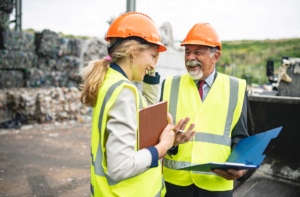The Current State of Recycling in the USA: A Comprehensive Analysis
Recycling plays an integral role in preserving the environment and promoting sustainability. And with the world growing increasingly conscious of the environmental impact of their consumption habits, the trajectory for sustainability shows promise
In this article, we will explore the current state of recycling in the USA, examining its history, government initiatives, public engagement, recycling infrastructure, types of recyclable materials, and recycling rates as they stand today. Through fostering an understanding of the state of recycling in the USA, we can identify areas for improvement and work towards a more sustainable future.
Overview of Recycling in the USA
Recycling in the USA has undergone significant evolution, driven by growing environmental awareness and the need to address the challenges posed by waste. The beginnings of recycling can be traced back to grassroots movements in the 1960s and 1970s, which went on to lay the foundation for widespread adoption.
Today, recycling has become a more mainstream practice, thanks in part to the efforts of the government, organizations, and individuals alike–all taking greater cognizance of their responsibility toward preserving a fragile Mother Earth.
Government Initiatives and Regulations
The US government has played a crucial role in promoting recycling through initiatives and regulations. Federal laws, such as the Resource Conservation and Recovery Act (RCRA) and the Solid Waste Disposal Act, provide an all-encompassing framework for waste management and recycling practices–seeing to it that these are practiced responsibly and ethically. Additionally, various government agencies, such as the Environmental Protection Agency (EPA), regularly collaborate with state and local governments to run and implement recycling programs and enforce accompanying regulations.
Public Awareness and Participation
Public awareness and participation are key drivers of successful recycling programs. The general public has become increasingly aware of the environmental impact of waste and the importance of recycling, indicating a positive movement towards green consciousness.
Educational campaigns, community outreach programs, and initiatives by environmental organizations have helped raise awareness and encourage individuals to actively participate in recycling efforts, placing emphasis on the gravity of how one’s individual actions when it comes to waste management can have either a positive or negative impact on the environment.
Recycling Infrastructure
A well-developed recycling infrastructure is crucial for efficient waste management. The USA employs a range of collection methods and programs, including curbside pickup, drop-off centers, and recycling bins in public spaces. These initiatives look to make recycling convenient and accessible for all citizens of all ages and classes.
Recycling facilities and technologies have also advanced significantly, allowing for the processing and transformation of recyclable materials into new products, a process otherwise known as upcycling. However, challenges such as limited infrastructure in certain regions due to lack of buy-in and funding, and contamination of recycling streams, continue to pose obstacles to widespread consciousness of sustainable practices.
Types of Recyclable Materials
Recycling encompasses a wide array of materials, each with unique challenges and benefits. Paper and cardboard recycling help conserve forests and reduce the demand for virgin materials. Plastics, while posing challenges due to their diverse compositions, can be recycled into new products, reducing plastic pollution and conserving resources. Glass recycling not only saves energy and raw materials but also reduces the burden on landfills. Metals, including aluminum and steel, are highly recyclable and can be transformed into new products while reducing energy consumption. Electronic waste recycling is essential to recover valuable materials and prevent environmental harm.
Recycling Rates and Statistics
Tracking and measuring recycling rates provide insights into the effectiveness of recycling efforts. The national recycling rate in the USA has shown improvement over the years, but there is still ample room for growth. According to the United States Environmental Protection Agency (EPA), the recycling rate in the US has increased from less than seven percent in 1960 to the current rate of 32 percent. An EPA study further found that recycling and reuse activities in the United States accounted for 681,000 jobs and $37.8 billion in wages.
Recycling rates can vary significantly among states due to differences in infrastructure, policies, and cultural practices. Comparisons with other countries shed light on different approaches and provide benchmarks for the USA to strive for greater effectiveness in recycling practices.
Environmental Impact of Recycling
Recycling has several environmental benefits. It conserves energy by:
- Reducing the need for extracting and processing raw materials.
- Recycling also contributes to the reduction of greenhouse gas emissions, as the production of recycled materials often requires less energy compared to producing new materials.
- It helps conserve natural resources by extending the lifespan of existing materials.
Challenges and Future Prospects
Contamination and improper sorting of recyclables remain persistent challenges in recycling. Limited infrastructure and funding pose stumbling blocks stifling the expansion of existing recycling programs.
However, technological advancements, such as improved sorting and processing technologies, show promise for overcoming these challenges. Embracing a circular economy model and sustainable practices can further enhance the effectiveness of recycling efforts.
Promoting Recycling and Individual Actions
Education and awareness campaigns are instrumental in fostering a culture of recycling. By educating individuals about the benefits and best practices of recycling, we can encourage responsible consumer behavior.
Supporting local recycling programs, such as participating in curbside pickup or utilizing community drop-off centers, can aid to the success of recycling initiatives.
The current state of recycling in the USA reflects the progress made in waste management and sustainability efforts since its humble beginnings in the 1960s. Recycling has significant environmental benefits, including energy conservation, reduction of greenhouse gas emissions, and conservation of natural resources. However, challenges such as contamination, limited infrastructure, and funding require attention. Through promoting recycling through education, responsible consumer behavior, and support for local programs, individuals can contribute to recycling efforts.
CheckSammy is a leading provider of comprehensive waste management and recycling services in the US. Our range of services encompasses various aspects of waste management, helping businesses and individuals minimize their environmental impact and promote sustainability across the board. With a focus on sustainability, we strive to offer innovative and environmentally responsible waste management solutions to meet the diverse needs of our clients.
Together, we can build a more sustainable future by embracing recycling as a fundamental practice and working towards a circular economy that minimizes waste and protects our planet for future generations. Contact CheckSammy to make a difference in the way you manage waste today.
See Our Services
Create a custom solution to meet your waste and sustainability goals. Contact us today!
Continue reading
Dive deeper into the CheckSammy Blog by reading one of our posts below
Feeling the Pain of Higher Resident Turnover? Apartment Junk Removal Can Help
If you’re a property manager, you’ve probably had a significant increase in tenant turnover over the last couple of years. So it’s no wonder apartment junk removal may be top of mind for you right now. There are several reasons for this shift. For one, the housing market is on fire right now. In 2020 […]
Read More About Feeling the Pain of Higher Resident Turnover? Apartment Junk Removal Can HelpSetting Up a Community E-waste Recycling Program
E-waste is the fastest-growing municipal waste stream according to the EPA, yet e-waste recycling isn’t keeping pace. In fact, only 12.5% of all e-waste is recycled, reports the EPA. Starting a community e-waste recycling program is a terrific way to ensure hazardous e-waste, like lithium-ion batteries, doesn’t end up in your community’s landfill. Creating an […]
Read More About Setting Up a Community E-waste Recycling ProgramWaste Management’s Role in the Circular Economy
Establishing a waste management program for your business or community is one of the best ways you can contribute to the circular economy. Here’s everything you need to know about waste management’s role in the circular economy (and how to get involved). What Is the Circular Economy? Our current economic model is all about taking […]
Read More About Waste Management’s Role in the Circular Economy5 Reasons to Consider a Textile Recycling Program for Your Organization
Americans sent more than 17 million tons of textiles to landfills in 2018, a volume that is only increasing every year, reports the Environmental Protection Agency. When you think about the fact that it can take over 200 years for textiles to decompose, it’s easy to grasp how large textile waste’s contribution is to the […]
Read More About 5 Reasons to Consider a Textile Recycling Program for Your Organization8 Benefits of Environmentally Friendly Power Washing Services
If you’re into maintaining the curb appeal of your business or home, then you’ve probably heard of pressure washing. Pressure cleaning involves using high-pressure water spray to remove grime, mold, dust, paint, mud, and other junk from objects or surfaces. Many people worry that pressure washing isn’t good for the environment, but this couldn’t be […]
Read More About 8 Benefits of Environmentally Friendly Power Washing ServicesWhy Our Customers Love Our Full-Service Junk Removal
If you’re looking for full-service junk removal services, you’ve come to the right place. CheckSammy is a one-stop shop for all your junk removal and sustainability needs. From our affordability, simplicity, and unrivaled turnaround times to our innovative sustainability solutions and patented technology and data, it’s clear why some of North America’s biggest companies choose […]
Read More About Why Our Customers Love Our Full-Service Junk RemovalTips for a Stress-Free Move From An Eco-Friendly Junk Removal Company
What does an eco-friendly junk removal company know about moving? Quite a lot, actually. Moving can be an especially chaotic time. You have to pack everything up, get rid of unwanted items, clean your property, load everything up, and move your things to your new location. That doesn’t even include the unpacking and resettling period. […]
Read More About Tips for a Stress-Free Move From An Eco-Friendly Junk Removal CompanyCollege Junk Removal Tips for Student Move-In Day
As the new school year gears up, colleges across the country are looking for ways to clean up their campuses before the new year begins, and many of them want to do so sustainably. College junk removal isn’t easy, though, especially around move-in week—and when trying to do so sustainably. As students move in and […]
Read More About College Junk Removal Tips for Student Move-In Day8 Items Hospitality Businesses May Not Know They Can Recycle
One hotel guest produces 2.5 pounds of trash every single day. Just a single hotel room produces around one cubic yard of waste each month, which totals 200 gallons of waste per room every month. Most of this waste goes straight to the landfill, even though research shows that up to 60% of it is […]
Read More About 8 Items Hospitality Businesses May Not Know They Can Recycle












